Forum Replies Created
-
AuthorPosts
-
24 October 2018 at 1:54 pm in reply to: A confirming spectrum for Nova in M31, TCP J00420310+4102331 #580082
 Robin LeadbeaterParticipant
Robin LeadbeaterParticipantNow confirmed as an Fe II nova by Wiliams et al from a spectrum taken using the Liverpool Telescope.
http://www.astronomerstelegram.org/?read=12138
(My spectrum taken a day earlier is also referenced there)
Robin
 Robin LeadbeaterParticipant
Robin LeadbeaterParticipantI was thinking perhaps the workshop could be based around some standard targets that participants would record beforehand. By processing these and comparing the results between each other and to the published spectra, any potential issues with spectrograph setup, data acquisition or processing would then be highlighted. (Something that I know helped me during an OHP workshop when I started out trying to get good quality data.)
Robin
 Robin LeadbeaterParticipant
Robin LeadbeaterParticipantHi Tony
ISIS apparently does not work with the current gnuplot . Try v4.4.6 perhaps ? eg the same problem reported here
http://www.spectro-aras.com/forum/viewtopic.php?f=10&t=2139
Robin
 Robin LeadbeaterParticipant
Robin LeadbeaterParticipantIt seems ALPY grisms out of adjustment is a common problem. I thought I remembered commenting on this here before
https://britastro.org/node/14085
Robin
 Robin LeadbeaterParticipant
Robin LeadbeaterParticipantThat’s great !. If you still have problems with the spectrum horizontal, you can also adjust the ALPY grism to make the lines exactly vertical. If you look at the core module,you can see the grism held in place by allen head grub screws. If you loosen them off you can rotate the grism, viewing a spectrum by eye until the spectral lines are square to the dispersion direction. (Take care not to loosen to much and hold the grism holder in place as there is a spring behind it)


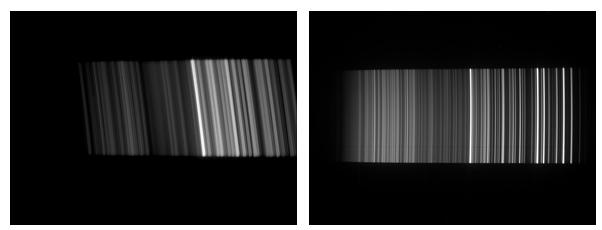
 Robin LeadbeaterParticipant
Robin LeadbeaterParticipantFor any LHIRES /LISA users which might be following this, The error is specific to the smile correction used with the ALPY. I have checked the slant correction that ISIS uses with LHIRES, LISA and this works correctly.
Robin
 Robin LeadbeaterParticipant
Robin LeadbeaterParticipantAs a further test, the calibration also runs ok with the original X position (though with slightly lower precision and resolution and poor sky background subtraction of course) if you run without the smile correction (by putting a very large value for the radius)
 Robin LeadbeaterParticipant
Robin LeadbeaterParticipantI agree. I found it by looking at the position of the lines in the geometric corrected spectrum image. (This could be a work round by running the calibration a second time applying the offset seen in the image ) I am awaiting feedback from Christian
Robin
 Robin LeadbeaterParticipant
Robin LeadbeaterParticipantHi John,
See answer #9 above for the source of the problem. Actually, I see now that the slant of the lamp lines is partly because the dispersion is not exactly horizontal, as seen in the star image. If next time you rotate the camera to make the star spectrum horizontal, the calibration might run ok without needing to change the X position entered or adjust the grism.
Cheers
Robin
 Robin LeadbeaterParticipant
Robin LeadbeaterParticipantThanks for the files. I now see the problem. When ISIS does the geometric correction for smile, this shifts the X positions of the lines so the entered X reference position for the line that ISIS works out the other lines from is not correct and it cannot lock on. This does not give a problem if the lines are close to vertical, for example in my case the shift is only 2 pixels. If there is a significant slant though the shift can be significant (+15 pixels in your case) If you add 15 pixels to the reference position, I think you should find the calibration runs correctly. Can you try it and see what happens? (It ran for me giving an RMS of 0.3A but I have not tried it combined with the Balmer lines using the wizard)
The slant can be corrected in the ALPY by rotating the grism to make the lines perpendicular to the dispersion direction. (It is simple to do. I did this with my ALPY when I received it and I will dig out the instructions) but I am a bit surprised ISIS does not take this shift into account. I will check with Christian Buil via the ARAS forum
Cheers
Robin
 Robin LeadbeaterParticipant
Robin LeadbeaterParticipantYou can download my lamp image here
https://drive.google.com/open?id=1I1UiZhmynSmkF19Fq3ce9foTsRF93ZgN
Robin
 Robin LeadbeaterParticipant
Robin LeadbeaterParticipantIt could also be worth exploring pixels sizes more widely either side. With my setup (an ATK428, smaller but with same size pixels) I get a good lock and calibration (RMS 0.13A) for 2x binned pixel sizes between 8.90 and 9.06 for a nominal 4.54×2 = 9.08. Using the 3123/(difference in pixels between H alpha and H beta) formula, I get 9.02 which is towards the top end of the lock range
(I was going to attach an example lamp image for comparison but max allowed size is 2Mb and zipped files are not allowed. Can you send me your image via email to robin_astro (at) hotmail.com please)
Robin
 Robin LeadbeaterParticipant
Robin LeadbeaterParticipantHi John
Yes that is the right reference line. ISIS should definitely work with the camera you have and the method I suggested, I use it all the time. (The high errors means ISIS is failing to find and lock onto the correct lines)
Can you check that the smile correction has worked correctly please. Run the calibration on the lamp spectrum itself instead of the target star, ticking sky background not removed. (you will need to put a 1 on the end of the file name so ISIS sees it as the first of a series) If you then examine the image (“display image”) in the page you get after pressing go, the lines should be vertical and straight.
Can you also post the original image as a zip file please and I will see if I can get it to work this end.
Cheers
Robin
 Robin LeadbeaterParticipant
Robin LeadbeaterParticipantHi John,
Does it work ok with just the calibration lamp? ie without the wizard,ticking “predefined mode” “ALPY (calibration module)” in “general” and entering the position of the 5852 line in “calibration”
Robin
 Robin LeadbeaterParticipant
Robin LeadbeaterParticipantYes, that’s great.
Thanks !
 Robin LeadbeaterParticipant
Robin LeadbeaterParticipantHi David,
Yes I saw your image. These are really useful as it helps with finding the target and spotting useful nearby guide stars. It is annoying I could not pin down exactly what type it is. I have had some feedback from a professional using a different fitting program on my spectrum and he favours it being a type 1c. This would makes sense as a 1a-91T-like should be significantly brighter at this distance, though that could be down to extinction.. Hopefully I will get another go before it fades too much and perhaps it will have evolved enough to pin it down.
Cheers
Robin
 Robin LeadbeaterParticipant
Robin LeadbeaterParticipantChanges in H alpha over past 6 days
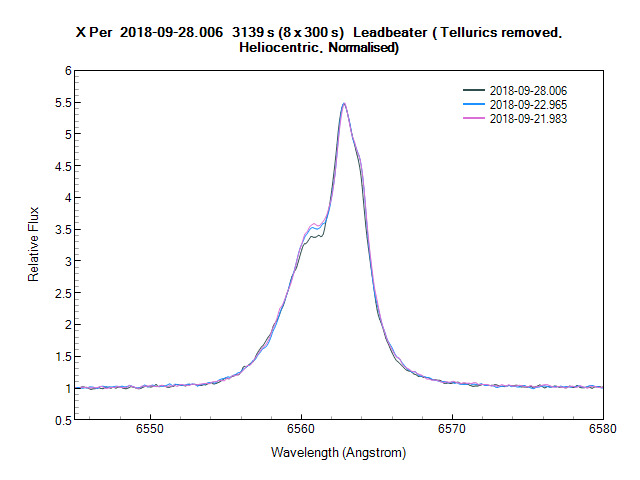
The He I 6680 line (approximately 15x weaker than H alpha)
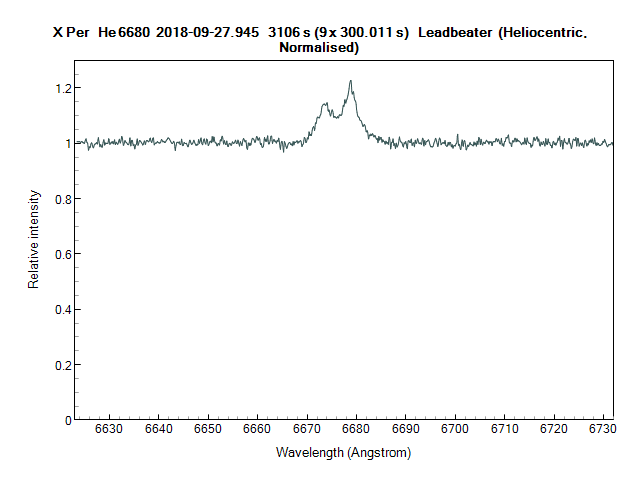
Radial Velocity of both lines (km/s, plotted in system rest frame)
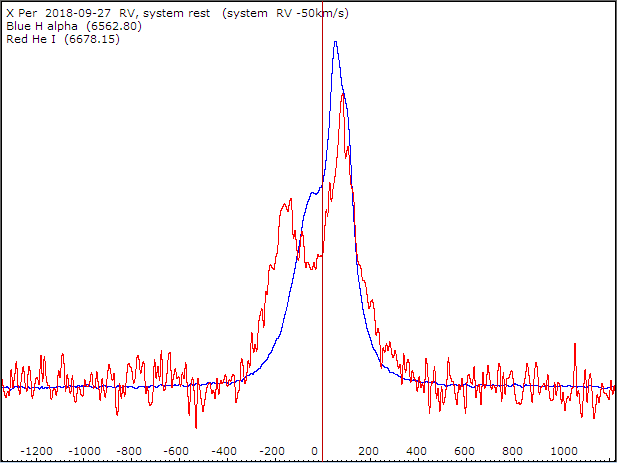
Cheers
Robin
 Robin LeadbeaterParticipant
Robin LeadbeaterParticipantMeteor spectroscopy is possible with the Star Analyser and a wide field camera
http://www.threehillsobservatory.co.uk/astro/spectra_20.htm
but a grating with higher dispersion would be better eg 300 or even 600 l/mm depending on the lens focal length and sensor size. Bill Ward would be able to advise on the optimum setup
https://britastro.org/user/213
Cheers
Robin
 Robin LeadbeaterParticipant
Robin LeadbeaterParticipantHere is how the H alpha line looks currently. (LHIRES 2400 grating, R~15000). Also uploaded to the BAA spectroscopic database
Robin
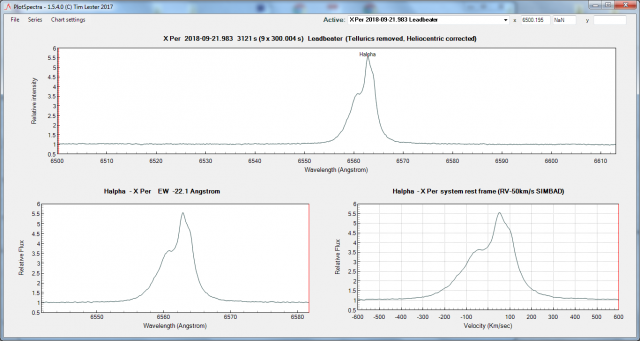
 Robin LeadbeaterParticipant
Robin LeadbeaterParticipantHi Paul,
I think he sort of did 😉 You could PM for details
-
AuthorPosts
